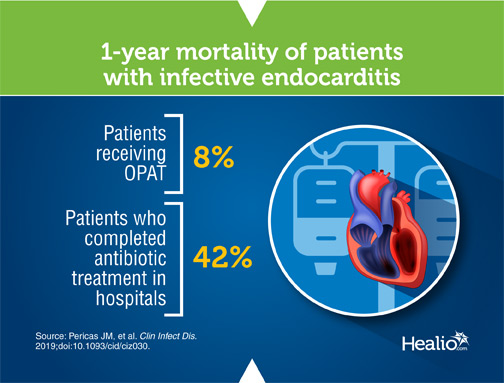Less restrictive OPAT criteria for infective endocarditis safe, effective
Outpatient parenteral antibiotic therapy for the treatment of infective endocarditis was found to be safe and effective, despite the use of less restrictive criteria than those recommended by the Infectious Diseases Society of America.
In 2001, IDSA established criteria for selecting patients with infective endocarditis (IE) for outpatient parenteral antibiotic therapy (OPAT). Currently, only patients with uncomplicated left-sided mitral or right-sided native valve IE caused by nonaggressive, easy-to-treat streptococci and without indications for cardiac surgery or clinical, echocardiographic or microbiological complications can be considered to complete antibiotic treatment via OPAT.
“OPAT is a good alternative for shortening the length of hospital admission while preserving patients’ safety and convenience of treatment,” Juan M. Pericàs, MD, PhD, MPH, clinical researcher at Hospital Clínic de Barcelona, and colleagues wrote. “Expanding its use might lead to an improvement in the subjective well-being of patients, a reduction in nosocomial infections, and optimization of budget allocations.”
To compare the outcomes of patients who received OPAT with those who received hospital-based antibiotic treatment (HBAT) — or standard hospitalization until the IV antibiotic therapy course was completed — Pericàs and colleagues retrospectively analyzed data from 25 Spanish centers that were included in the multicenter prospective observational cohort study, GAMES. From 2008 to 2012, the study enrolled 2,000 consecutive patients with IE. Because the IDSA criteria are not clear regarding IV drug users, these individuals were not considered suitable candidates and were excluded from the study. The study outcomes included readmission for any cause at 90 days, cardiac surgery within the first year after discharge, relapses and 1-year mortality.
According to the study, 21.5% of the cohort received OPAT, and only 21.7% of that group met IDSA criteria. The median age of patients was 68 years, and men comprised 70.5% of the cohort. The researchers said 57% of patients had native valve IE, 27% had prosthetic valve IE and 19% had pacemaker/defibrillator IE. Viridans group streptococci was the most frequent casual microorganism — observed in 18.6% of cases — whereas 15.6% were Staphylococcus aureus and 14.5% coagulase-negative staphylococci. Antibiotic treatment lasted a median of 42 days, and cardiac surgery was performed on 44% of patients, according to the study.
Pericàs and colleagues observed a 1-year mortality rate of 8% among patients who received OPAT compared with 42% for those receiving HBAT (P < .001). In the OPAT group, 1.4% of patients relapsed and 10.9% were readmitted during the first 3 months after discharge, and the researchers observed no significant differences compared with HBAT. The researchers discovered that 1-year mortality was associated with Charlson score (OR = 1.21; 95% CI, 1.04-1.42) and cardiac surgery (OR = 0.24; 95% CI, 0.09-0.63). The only predictor of readmission at 1 year was aortic valve involvement (OR = 0.47; 95% CI, 0.22-0.98), the researchers noted. Furthermore, nonadherence to IDSA criteria was not observed to be a risk factor for mortality or readmission.
”As a general rule, it seems reasonable to consider as candidates for OPAT all patients with endocarditis not caused by difficult-to-treat microorganisms requiring complex antibiotic combinations and not presenting clinical, echocardiographic, or post-surgical complications that have not resolved shortly after onset,” Pericàs and colleagues wrote. “Naturally, an individualized assessment of each patient performed by OPAT-skilled physicians might lead to rejection of OPAT for more specific reasons. General recommendations apply only to centers with established OPAT programs meeting all appropriate requirements, including a well-organized multidisciplinary team, excellent communication and monitoring systems, and proper physical and support conditions in the patients’ homes or outpatient clinic.” – by Marley Ghizzone
Disclosures: Pericàs reports no relevant financial disclosures. Please see the study for all other author’s relevant financial disclosures.

